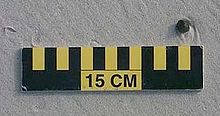Tarball (oil)


A tarball is a blob of petroleum which has been weathered after floating in the ocean. Tarballs are an aquatic pollutant in most environments, although they can occur naturally and as such are not always associated with oil spills.[1][2][3]
Tarball concentration and features have been used to assess the extent of oil spills and their composition can also be used to identify their sources of origin.[4][5] They are slowly decomposed by microorganisms such as Chromobacterium violaceum, Cladosporium resinae, Bacillus submarinus, Micrococcus varians, Pseudomonas aeruginosa, Candida marina, and Saccharomyces estuari.[1]
Tarballs may be dispersed over long distances by deep sea currents.[2] The density of tarballs depends on the solids picked up in the weathering process.[6] They can range in density with some being more dense than seawater, which, at 1.025 g/ml, is more dense than the density of fresh water. When the tarballs are less dense than seawater, they can travel over great distances.
They can also be contained like oil and picked up using a variety of methods. Containment booms can be used to isolate tarballs similar to methods used to isolate oil.[7][8]
References
- ^ a b Itah, A. Y.; Essien, J. P. (October 2005). "Growth Profile and Hydrocarbonoclastic Potential of Microorganisms Isolated from Tarballs in the Bight of Bonny, Nigeria". World Journal of Microbiology and Biotechnology. 21 (6–7): 1317–1322. doi:10.1007/s11274-004-6694-z.
- ^ a b Hostettler, Frances D.; Rosenbauer, Robert J.; Lorenson, Thomas D.; Dougherty, Jennifer (June 2004). "Geochemical characterization of tarballs on beaches along the California coast. Part I: Shallow seepage impacting the Santa Barbara Channel Islands, Santa Cruz, Santa Rosa, and San Miguel". Organic Geochemistry. 35 (6): 725–746. doi:10.1016/j.orggeochem.2004.01.022. ISSN 0146-6380.
- ^ Lorenson, T. D.; Hostettler, F. D.; Rosenbauer, R. J.; Peters, K. E.; Kvenvolden, K. A.; Dougherty, J. A.; Gutmacher, C. E.; Wong, F. L.; Normark, W. R. (2009). "Natural offshore seepage and related tarball accumulation on the California coastline; Santa Barbara Channel and the southern Santa Maria Basin; source identification and inventory". usgs.gov. US Geological Survey. Retrieved 2010-06-03.
- ^ Knap, Anthony H.; Burns, Kathryn A.; Dawson, Rodger; Ehrhardt, Manfred; Palmork, Karsten H. (July 1986). "Dissolved/dispersed hydrocarbons, tarballs and the surface microlayer: Experiences from an IOC/UNEP Workshop in Bermuda, December 1984". Marine Pollution Bulletin. 17 (7): 313–319. doi:10.1016/0025-326X(86)90217-1.
- ^ Wang, Zhendi; Fingas, Merv; Landriault, Michael; Sigouin, Lise; Castle, Bill; Hostetter, David; Zhang, Dachung; Spencer, Brad (1998). "Identification and Linkage of Tarballs from the Coasts of Vancouver Island and Northern California Using GC/MS and Isotopic Techniques". Journal of High Resolution Chromatography. 21 (7): 383–395. doi:10.1002/(SICI)1521-4168(19980701)21:7<383::AID-JHRC383>3.0.CO;2-3.
- ^ Goodman, R. (April 2003). "Tar Balls: The End State". Spill Science & Technology Bulletin. 8 (2): 117–121. doi:10.1016/S1353-2561(03)00045-8.
- ^ Fang, J.; Wong, K. V. (January 2006). "An Advanced VOF Algorithm for Oil Boom Design". International Journal of Modelling and Simulation. 26 (1): 36–44. doi:10.1080/02286203.2006.11442349.
- ^ Fang, J.; Wong, K. V. (April 2003). "An Advanced VOF Algorithm for Oil Boom Design". International Journal of Modelling and Simulation. 8 (2): 117–121.
Further reading
- "Understanding Tar Balls" (PDF). NOAA. 24 May 2010. Retrieved 23 Feb 2021.
- Than, Ker (14 May 2010). "Gulf Oil Spill Pictures: Oil, Tarballs Hit Beaches". National Geographic Daily News. National Geographic. Retrieved 21 May 2010.
